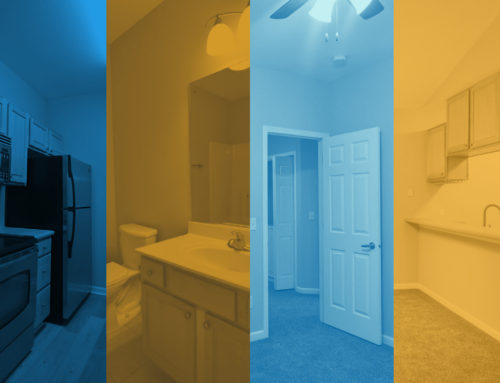
Wondering if it makes sense to rent your house? Perhaps you bought a house as an investment property? Maybe you’re moving and can’t sell your current home? Did you inherit a house and aren’t sure what to do with it?
Whatever your reason for renting your house, you need to do it right from the beginning. Taking the right steps means taking a little extra time and effort. But each step is critical if you want to be successful – and avoid major headaches down the road.
Before getting to the guide to the basic steps on how to rent your house, make sure you’re ready. The steps in this guide make a few assumptions. If you cannot answer “yes” to the following questions, take a step back – and put in the work to get to a “yes.”
- Is your property turnkey? (Is it ready to live in?)
- Have you hashed out “why” you want to rent the house?
- Have you run realistic numbers? Have you determined if renting the house is a sound financial decision?
- Are you willing to take the time and effort to find the right tenant? (If not, rethink it or hire a property manager.)
- Do you know who will manage the property? (If you plan to manage it, do you understand what that entails?)
What does a property manager do?
Most property managers charge 10% of the monthly rent. There are extra fees for a new property set up, new leases, and additional services. If you’re trying to decide whether to hire a property manager, here’s a list of some of the things most property managers will do for you:
- Advertise the house for rent
- Show the property
- Rental applications
- Qualify tenants
- Lease signing
- Rent collection
- Track income/expenses
- Take calls from tenants
- Schedule repairs and maintenance
- Distribute legal notices
- Serve evictions
The property manager typically arranges repairs, maintenance, legal notices, and evictions. You are responsible for paying for third-party services arranged by the property manager.
If you decide not to hire a property manager, you will need to take care of the tasks on your own.
The basic steps on how to rent your house
The numbers
Monthly rent
First things first – you have to know how much your house will rent for. Not what you want to rent it for, but what tenants are willing to pay. Be objective when researching “fair market rent” for your house.
If you inflate your rent prices, the only person you’re hurting is you. Tenants are looking for the best value for the money, so your rent price should be competitive with similar rentals in your area.
There are a few ways you can research how much you can charge for rent:
- HUD Fair Market Rents site
- Rentometer
- Apartments.com
- Craigslist
- Facebook Marketplace
- Trulia
- Local newspaper online classifieds
- Ask fellow investors (join a free and local real estate investing meetup)
- Call your property manager and ask
Find great tenants to rent your house
Good tenants make all the difference in the success of your rental house.
In the long run, it’s worth it to take the extra time to find good tenants – when it saves you a ton of money and headaches.
Or, you can hire a property manager to find a tenant for you. You won’t have to advertise, prescreen, or show the property to prospective tenants when you hire a property manager.
Set your rental application standards
Your rental application standards are a set of criteria a tenant must meet to qualify to rent your home. You must have specific, written standards (and stick to them).
Your rental standards ensure you get the right tenant. And, if you document everything, they can protect you in the case of a discrimination claim.
Your rental criteria might include:
- Minimum gross monthly salary (ex. Monthly income is = or > 3x rent)
- Provide written proof of income (pay stubs)
- Work history (proof of steady employment for a set amount of time)
- Minimum credit score
- Good credit history (no bankruptcies, collections, judgments, etc. in set time frame)
- References from previous landlords
- Rental history (from recent years)
- Number of occupants (check local laws)
- Smoking/No smoking
- Pets/No pets (or restrictions on size/type)
Be consistent. When you’re consistent and make sure all applicants fit your rental standards, you will get the right tenants. Not only that, but you can help protect yourself against any discrimination claims when an applicant is denied.
Do not discriminate: Federal law prohibits you from discriminating against tenants based on a person’s race, skin color, sex, national origin, religion, disability or familial status. Iowa code expands on this to also prohibit discrimination based on creed, sexual orientation, and gender identity.
Advertise your house for rent
To find the best tenants, market your property effectively. You want to reach the most potential tenants as possible. The more tenants you have to choose from, the better your odds of finding a great tenant.
Where to advertise:
- Craigslist
- Facebook Marketplace
- Trulia
- Apartments.com
- Yard signs
Include great photos of the house. Provide details on square footage, number of bedrooms and bathrooms, parking, amenities, and all other relevant information on the property. Include information on lawn care and snow removal.
When you provide all the information on the property up-front, you minimize calls from prospective tenants. This will save you a ton of time since they already have the answers to their questions.
Explain your rental standards and pre-screen prospective tenants before showing the house
Prescreen prospective tenants to see if they meet your documented rental standards before showing the property or having them complete an application.
Provide prospective tenants with your rental standards when you speak to them (or email them) in response to their inquiry on the property. Communicate your rental standards in writing (see above). You can then ask them if they meet the qualifications. If they do, then you can show them the property and/or go through the application process.
Show your property*
Potential tenants are looking at many homes. You want yours to stand out as the best value.
- Clean up the property, and make sure the temperature and lighting are adequate at the time of showing.
- Consider staging your property to make it stand out.
- Show the entire property, not just certain parts of the property.
- Consider scheduling showings back-to-back – or time blocking, open house style – to save you time.
- Provide prospective tenants with the details of the house and the rental standards, as well as rent and security deposit information – in writing.
- Answer questions about the property and the lease.
- Explain the application process (and disclose your application fee). For those interested, provide an application and authorization for a background and credit check.
- We also recommend you do a day-of-showing follow-up and confirmation after showings.
*If you have tenants living in the property while you’re advertising for new tenants, by law you need to give the current tenants 24-hour notice before showing the property. That said, it’s much better (and easier) to show a vacant property.
Application
The application process is super important when it comes to finding the right tenant. This is the time when you compare the results of the application to your rental standards.
Sticking to your set rental standards is critical. The whole reason you took the time to create them is to have good tenants and minimize your risk. When you waiver on your standards, it puts you at a higher risk for poor quality tenants and claims of discrimination.
What the application includes
The application gathers all the information needed to determine if the tenant meets your set rental standards.
Let prospective tenants know all information on the application is required, and the application will not be processed until it’s complete. You can provide the tenant with a checklist of items needed for a complete application.
Things the application should include:
- Name
- Current address and phone number
- Date of Birth
- Social Security number
- Previous Addresses
- References contact information [previous landlords (past 2 years), current landlord, employer]
- Employment information (dates, address, phone number, income)
- Signature for permission to check credit, do a background check, and call references.
Besides the application, ask for:
- Proof of income (2-3 pay stubs, W-2, bank statements, 1099s, etc.)
- Application fee (a reasonable amount, determined by you)
Charging an application fee
There are a few reasons you’ll want to charge prospective tenants an application fee:
- Lets prospective tenants know you will follow through on the background check.
- Determines if the applicant is serious about renting your property.
- Covers your cost and time of doing a background check.
- If you choose, you can apply the application fee to the tenants’ security deposit if they are approved.
Do the tenant credit/background check
This step is crucial to determine if a tenant meets your rental criteria. The background check provides information on the applicant’s history and helps you determine the risk of renting to them.
You can do a credit check on your own to save money (if you choose, you can also do a full background check). Or you can hire a service to do this step for you. But, be aware, not all services are created equal.
Some property management platforms, like Cozy, make background checks easier. For instance, Cozy allows you to send a link directly to the prospective tenant for them to complete a credit/background check. The tenant then pays to get a report, completes the information, and decides whether to share the information with you.
Credit checks include information from the three credit bureaus (Transunion, Equifax, and Experian), including:
- Credit score (a three-digit score, between 300-850, indicating financial health – higher is better)
- Credit report (detailed history of the applicant’s finances)
The credit report provides applicants’:
- Personal information (name(s), AKAs, current address, etc.)
- Address history
- Income
- Employment history
- Lines of credit (loans, revolving credit, tradelines)
- Collections (indicating pattern of late payments)
- Inquiries on their credit (when others have pulled credit)
- Public records (including bankruptcies, civil judgments, tax liens, and any evictions that resulted in a court judgment)
Criminal records
A credit report will not include criminal records. You have to do a full background check to access criminal records. But it’s important to note that you cannot deny an application based on an arrest without a conviction. Even if there was a conviction, you need to weigh whether it is legal to refuse to rent to an applicant based on their criminal record (see below).
From HUD: “Policies that exclude persons based on criminal history must be tailored to serve the housing provider’s substantial, legitimate, nondiscriminatory interest and take into consideration such factors as the type of the crime and the length of the time since conviction. Where a policy or practice excludes individuals with only certain types of convictions, a housing provider will still bear the burden of proving that any discriminatory effect caused by such policy or practice is justified. Such a determination must be made on a case-by-case basis.”
Verify income
It’s important to check the applicant’s credit report to see if the income listed on the application lines up with the amount on the credit report. Investigate all discrepancies to determine the accuracy of the information on the application.
You need written proof of income based on documentation provided by the applicant. This could include pay stubs, W-2s, tax returns, or 1099s.
Check rental history and references
It takes a little extra time to make phone calls to landlords (and/or employers), but it makes a big difference in determining the risk of an applicant.
Questions to ask past/current landlords:
- Did you/Are you renting to the applicant?
- What’s the time frame the applicant rented from you?
- How much was/is the applicant’s rent?
- Did the applicant pay rent on time?
- What is the address where the applicant resided/resides?
- Would you rent to the applicant again?
- Were there any nuisance complaints about the applicant, from neighbors or others?
Accepting or denying the application
Go through your set rental standards to see if an applicant meets all the requirements. If they do, inform them they’re approved. Let them know you’ll follow up with an email (or letter) with instructions about “what’s next.”
If you deny an application, let the applicant know in writing. Always be prepared to back up any denial with documentation.
If the denial is based on information in the applicant’s credit report, by law you have to send the applicant a letter stating they were denied for information contained in the credit report. The letter should be a blanket statement providing no specific information. You cannot give them a copy of the credit report. Give them written details on how they can get a copy of their credit report.
Be consistent with applications and rental standards for all prospective tenants. Not only will consistency help you find good tenants, but it will also protect you from claims of discrimination.
Tenant found!
Once you’ve found a great tenant, give them the steps they need to complete before they move in (in writing). A checklist is handy for the tenant to use (and you too!).
Collect security deposit and first month’s rent
The security deposit is collected from tenants before they sign the lease. It indicates tenants’ intent to follow through on the terms of the contract.
A security deposit is like insurance for the landlord – insurance against damage or excessive cleaning needed to restore the property to its original, move-in condition.
The landlord or property management company holds the security deposit in a separate account* until the tenant moves out. At that time, the deposit is either refunded or used to pay for damage or cleaning.
As the property owner, you can decide how much to collect for a security deposit, but many states limit the amount you can legally charge. Iowa limits the security deposit to 2x the amount of the monthly rent.
Typically, landlords charge the equivalent of one month’s rent for the security deposit. But, some will increase the amount (while still adhering to state laws) if they feel the tenant poses a higher risk.
Collect the security deposit before the move in date. Set a deadline, within a week or so, to collect it. Provide tenants a receipt of payment.
You can limit the type of funds accepted to certified cashier’s check, money order, or electronic payment. But you have to provide at least two different ways to make the payment (i.e., you cannot require them to pay electronically).
*Property managers must keep the money in a separate interest-bearing account (but the income is remitted to the state). Landlords are exempt from needing an interest-bearing account up to a certain amount of money.
Give tenants local information they need
Go the extra mile! Prepare a list of info and phone numbers of local utility companies, schools, and services your tenants might need before move-in day.
Move-in day
Collect first month’s rent
The first month’s rent should be collected on or before the date the lease is signed.
The Lease
The lease is a legal document designed to protect the landlord.* It includes:
- Payment details (how much, due dates, late fees, etc.)
- Property information (boundaries, damage, owner’s rights, what can/can not be altered)
- Other relevant info
- Pets
- Parking
- Keys
- Noise/Complaints
- Illegal activity
*Your attorney needs to review your lease to ensure you are adhering to local laws and regulations.
The tenant signs the lease
Have your tenant sign the lease at the property on move-in day. Allow ample time to explain and review each section of the lease. Make sure the tenant understands everything. Answer their questions to their satisfaction.
It’s always a good idea to have the tenant initial each page or section of the lease, such as pet policies and late fees.
Move-in checklist
The move-in checklist documents the condition of the home on the day the tenant moves in. Walk through the property with the tenant as you go through your move-in checklist. Provide written details on the condition of each area of the rental property.
The tenant signs the form to verify the home’s move in condition.
Give the tenant a limited time to report extra damage they may find in the first few days after move-in.
You may also want to take photos to further document the condition of the home before the move in date.
The move-in checklist serves as a reference when the tenant moves out, especially when there is any question about damages.
Give the tenant the keys!
Collecting rent
Set up your rent collection procedures to limit late payments. The best way to do this is to make it easy for tenants to make their rent payments. If you can automate payments, even better.
Automation
Use an Automatic Clearing House (ACH). An ACH is when the tenant sets up electronic payments to come out of their bank account on a particular day of each month. Tenants have to sign a form for their bank authorizing these withdrawals.
This set-up works great as long as the tenant consistently has the rent money in their bank account.
Online bill payments
Tenants can also set up an automatic, recurring payment through their bank’s bill pay system.
Use online rent payment platforms
Online rent payment services allow your tenant to pay rent through websites, apps, text messaging, and more.
Most of these services will allow the tenant to pay with a variety of options besides their bank account. They may be able to pay with a credit card, debit card, PayPal, echecks, etc. This makes it easy and convenient for them to make their rent payments.
Hire a property manager
If you don’t want to deal with payments at all, the easiest (and least stressful) way to collect rent is to hire a property manager to take care of it for you!
If all else fails…
You can always call Sell Now Iowa. We buy all kinds of houses. Here’s a review from a pair of landlords who sold us their rental. Tod and Tracy were tired of dealing with tenants and all the responsibility that goes along with landlording. After a quick call to Sell Now Iowa, they made an appointment for the team to meet them at the property. Upon accepting our offer the closing day came fast and without a hitch!





